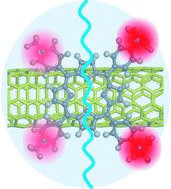Unravelling the mechanisms of reactive oxygen species formation in nanohybrid systems of porphyrins and enriched (6,5) single-walled carbon nanotubes for photosensitization†
Abstract
Nanohybrids of enriched (6,5) single-walled semiconducting carbon nanotubes (E-SWCNTs) and porphyrin can be used synergistically as photodynamic therapy (PDT) agents. The efficiency of different porphyrins within the nanohybrids was investigated and compared with results obtained from porphyrins in previous studies. Reactive oxygen species singlet oxygen 1O2 and for the first time hydroxyl radical ˙OH generation by the nanohybrids under illumination were detected by electron paramagnetic resonance using spin trapping molecules TEMP and PBN. Based on the analysis, we improve the modelling of charge transport within the nanohybrids, which is also detected by Raman scattering. It is shown that the 5,10,15,20-tetrakis(4-trimethylammoniumphenyl)porphyrin [H2TTMAPP(OTs)4] and E-SWCNT form very efficient nanohybrids for PDT applications in the visible spectral range.


 Please wait while we load your content...
Please wait while we load your content...